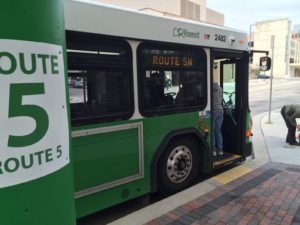When was the last time you took a ride on a city bus?
If you are like the city council and school board candidates I’ve asked, the answer is “not lately,” “ahhh,” or “can’t remember.”
Regular riders often fall into two categories: those who are most passionate and those who are most needy. About five years ago, with a wrecked vehicle and no steady job, I had a toe in each bucket, and decided our family could manage with only one car. My husband would drive to work, and I’d ride the bus.
The plan was nearly ditched the first day when I needed to visit Linn County offices, then located at Westdale Mall.
After seeing the children off to school, I walked to the closest bus stop from our Marion home and waited.

When the bus finally arrived, I smiled, stepped aboard and fed a $5 bill into the fare machine. Then I stood, looking around for my change.
“Take your seat,” the driver said. “It doesn’t give change.”
City Bus Riding 101, lesson one complete. More followed.
For instance, I expected public transit to be more time consuming than driving my own car, but vastly underestimated how much more.
That first day I think I spent as much time waiting on the bus as I did riding the bus. The kids were home from school before I made it back across town. Granted, this was partly due to my inexperience. But not entirely.
The more I relied on city buses, the more my world shrank. Businesses or events in other parts of the city no longer seemed worth the time or hassle. Few routes overlapped, meaning most trips required riding to the downtown transit hub to catch another bus to a different city section.
When a steady job offer arrived, the bus schedule mandated choosing between getting to work on time or seeing the kids off to school. Our family returned to two-car status — a luxury that wasn’t an option for many on the bus.
And, when the new job took me to larger cities where I’d need to rely on public transit, I panicked. After all, if service here was so time-consuming and inconvenient, what hope did a larger area have?
I learned Cedar Rapids was the exception, not the rule.
Buses (and — gasp — trains) were frequent. Refillable swipe cards replaced worry about exact fares. Free apps outlined the steps from Point A to Point B. In the busiest neighborhoods, “circulator” buses provided timesaving connections.
It was easy, affordable, fast and even enjoyable.
It’s no wonder public transit there carried a wide swathe of the populace — young and old, families, professionals, tourists. Unlike here, it didn’t feel shameful or like an option of last resort.
New public transit money will soon arrive in Cedar Rapids. That has local groups studying existing services, and I’d like to do my part.
Beginning May 1, I’ll ride the bus as if our family had one car, available to me only on nights and weekends. The following week I’ll pretend buses are my only option.
I plan to use daily blog posts to tell my story and, if they’re willing, the stories of others on the bus. Readers with specific route or task suggestions are encouraged to speak up.
To be sure, this is a non-scientific experiment. My hope is that it will provide a much lacking firsthand perspective.
See you on the bus.
This column by Lynda Waddington originally published in The Gazette on April 23, 2016.
